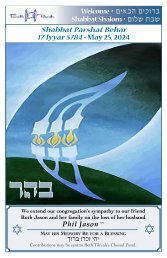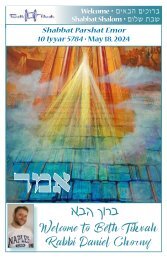Create successful ePaper yourself
Turn your PDF publications into a flip-book with our unique Google optimized e-Paper software.
Welcome • ohtcv ohfurc<br />
Shabbat Shalom • ouka ,ca<br />
Shabbat Parshat <strong>Tazria</strong><br />
5 Nisan 5784 • April 13, 2024<br />
ghrz`<br />
APRIL 14 th<br />
10:00 a.m.<br />
Dr. Jaclynn Faffer<br />
Confidence. Connection. Support:<br />
Three words that represent the pillars of strength we need to navigate<br />
the challenges of life. Dr. Faffer will share<br />
when and how to maximize one’s access to these pillars.<br />
NAPLES<br />
JEWISH<br />
FILM FESTIVAL<br />
The Nina Iser<br />
Jewish Cultural Center<br />
April 14th 7:00 p.m.<br />
NaplesJewishFilmFestival.org
Yahrtzeiten<br />
Apr 13<br />
Apr 16<br />
Apr 18<br />
Anniversaries<br />
Joan Lasser, Scott Rosenfeld<br />
Elena Mena<br />
Judith Adelman<br />
Apr 13 Carol & Stuaert Mest (38)<br />
vfrck oburfz<br />
Apr 9 • 1 Nissan Louis Michael Bogo – Son of Rosalee & Jerry Bogo<br />
Apr 12 • 4 Nissan Leslie Popkin – Sister of Fred Kamin<br />
Apr 13 • 5 Nissan Toby Engel – Relative of Joel Engel<br />
Apr 14 • 6 Nissan Melvin Toub – Husband of Joyce Toub<br />
Apr 15 • 7 Nissan Edith Katz – Mother of Debra Silow<br />
Apr 17 • 9 Nissan Bernice Drapkin – Mother of Eleanor Scheffler<br />
Apr 18 • 10 Nissan Mildred Keyser – Mother of Stephen Keyser<br />
Apr 19 • 11 Nissan Samuel Mest – Grandfather of Stuart Mest<br />
Birthdays<br />
jna `skuv ouh<br />
Shabbat Kiddush Sponsored by:<br />
Joyce Toub<br />
In memory of her husband Mel Toub<br />
rosalee & Jerry Bogo<br />
cuy kzn<br />
k ” z<br />
In Memory of their son Louis Michael and<br />
k ” z<br />
Rosalee’s brothers Sam & Leon Aronson<br />
Judy & Neil Adelman<br />
In honor of Judy’s birthday and in<br />
appreciation of Beth Tikvah<br />
Debra & Michael Silow<br />
In memory of her mother<br />
Edith Katz Hoffman k ”z<br />
Mavens: Roberta Miller & Rosalee Bogo<br />
Assisted by: Beverly Blazer, Lee Henson, Elaine Kamin,<br />
Arlene Levin, Judy Levitt, Gayle Levy, Paulette Margulies,<br />
Linda Scheinberg, Shep Scheinberg.
Torah & Haftarah Readings:<br />
Shabbat <strong>Tazria</strong>: Leviticus 13:29–13:59 (Cycle 2) (Etz Hayim p. 655)<br />
1. 13:29-34 2. 13:35-39 3. 13:40-42 4. 13:43-46<br />
5. 13:47-50 6. 13:51-54 7. 13:55-59 M. 13:57-59 (p. 659)<br />
Haftarah: II Kings 4:42-5:19 (p.672)<br />
Torah Commentary<br />
D’var Torah:<br />
The Little Girl - Bex Stern-Rosenblatt<br />
We read this week about how to maintain our community, even when there are people<br />
we must temporarily remove. Two examples are given: the postpartum woman and the<br />
person with skin disease, these people are separated from their regular lives and from the<br />
rest of the community, forbidden from contact with the rest of us, until their abnormal<br />
state has passed then the kohen welcomes them back into the community. We recognize<br />
the liminal states, the outside of the norm experiences, that occur. And we make room for<br />
them to occur without overwhelming the norms of our community. We separate those<br />
experiencing them and then welcome them back in afterward.<br />
Life is not all childbirth and skin disease. Our community is not optimized to support those<br />
going through childbirth or skin disease. Instead, we send them away to specialists and<br />
focus our own community on what we do best, which is creating holy spaces. By definition,<br />
childbirth and skin disease bring impurity, a form of corruption, with them. While we do<br />
not in any way disparage those birthing or experiencing skin disease, we also do not give<br />
up our commitment to holiness in order to make room for them within our community.<br />
The haftarah this week turns this whole system on its head. We read of a person with skin<br />
disease, but that person is Naaman, the army commander of Aram, our enemy. By his<br />
very nature, he is not part of our community. However, he comes to Israel to have his skin<br />
disease cured. Rather than being separated from us due to skin disease, it is his skin disease<br />
that brings him into contact with us. Once the disease is cured, he will leave our community<br />
and return to his home.<br />
Moreover, the story contains no mention of kohanim. Naaman will try to have the King<br />
of Israel cure him. When that fails, the prophet Elisha summons him for a cure instead.<br />
Repeatedly, we are told that the point is to learn that there is a prophet in Israel. Leviticus<br />
has been all about moving us from Moses’s prophetic leadership in the style of a king to<br />
priestly leadership under the kohanim. Coming many hundreds of years after the Exodus<br />
story in our parashah, the story of Elisha and Naaman has reverted to prophetic leadership.<br />
We are no longer concerned with contamination or the beit hamikdash. Elisha uses the<br />
Jordan River to purify Naaman.<br />
Most strikingly, we no longer seem to be concerned with self-definition. In a world with<br />
no priestly leadership and an incompetent king, a prophet chooses to use his power to cure<br />
one of our enemies. Perhaps we believe that if we only contribute enough good to the rest of<br />
the world, they will stop attacking us. However, Aram does not stop being our enemy. Just<br />
one chapter later, they will attack us yet again. The whole system described in the haftarah<br />
is a failure. The structures we find in our parashah, which the haftarah seemingly rejected,<br />
got something right.
Reading the haftarah in light of the parshah also encourages us to look for a parallel to the<br />
birthing woman from our parashah. We don’t find her, exactly. We do find one of our girls,<br />
taken captive, and forced to serve Naaman’s wife. It is this girl who will let Naaman know<br />
that his skin disease can be cured in Israel. She then disappears from the text. We never<br />
read of a rescue mission. We don’t learn of Elisha insisting that she be brought home before<br />
he cures Naaman. And in light of the birthing woman of our parashah, there is the horrible<br />
possibility that this girl, too, gives birth. In captivity. Bearing the children of our enemy.<br />
This week’s parashah gives us a roadmap, provides us with a way to welcome such people<br />
back home. We recognize that they have been through something that is both beyond the<br />
limits of our normal experience and also something that could happen to any of us. We<br />
provide them with the room to recover and the ritual to be rebirthed back into the homes<br />
they left behind.<br />
All Are invited to<br />
Join Beth Tikvah<br />
for a fun and<br />
Traditional Kosher<br />
Passover Seder<br />
Monday, April 22 nd<br />
6:30 p.m.<br />
Cost per person: Members $90<br />
Nonmembers $100<br />
RSVP by calling the Synagogue Office<br />
239-434-1818<br />
Minyan Request<br />
Minyan has been requested for<br />
Sunday, April 14 - 9:00 a.m.<br />
Services will be conducted In-Person<br />
and streamed via ZOOM<br />
Beth Tikvah of Naples<br />
1459 Pine Ridge Road<br />
Naples, FL 34109<br />
239 434-1818<br />
Visit us online at<br />
bethtikvahnaples.org<br />
or scan the QR code


















